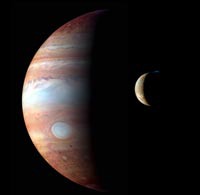Magma ocean found on Jupiter's moon Io
 NASA's Galileo spacecraft had an incredibly productive lifetime, capped by a tour of the planet Jupiter and its moons from 1995 to 2003. The spacecraft may have died in the Jovian atmosphere but the data it sent back is still being examined and new findings are being uncovered.
NASA's Galileo spacecraft had an incredibly productive lifetime, capped by a tour of the planet Jupiter and its moons from 1995 to 2003. The spacecraft may have died in the Jovian atmosphere but the data it sent back is still being examined and new findings are being uncovered.
Most recent is the discovery of a subsurface ocean of molten or partially molten magma beneath the surface of Jupiter's volcanic moon Io according to a new study by scientists at UCLA, the University of California, Santa Cruz, and the University of Michigan, according to .
"At any time, Io has 400 [and] maybe more active volcanoes," said study leader Krishan Khurana, a planetary physicist at the University of California, Los Angles.
"They are very powerful-they can shoot plumes out into space to a height of about 300 miles [500 kilometers]." Finding an extensive magma ocean means that "now we know why there are so many, and where the lava comes from," reports.
Torrence Johnson, a former Galileo project scientist, said of Io's hotbed of lava: "It has been suggested that both the Earth and its moon may have had similar magma oceans billions of years ago at the time of their formation, but they have long since cooled.
"Io's volcanism informs us how volcanoes work and provides a window in time to styles of volcanic activity that may have occurred on the Earth and moon during their earliest history," Johnson said, says.
Subscribe to Pravda.Ru Telegram channel, Facebook, RSS!


